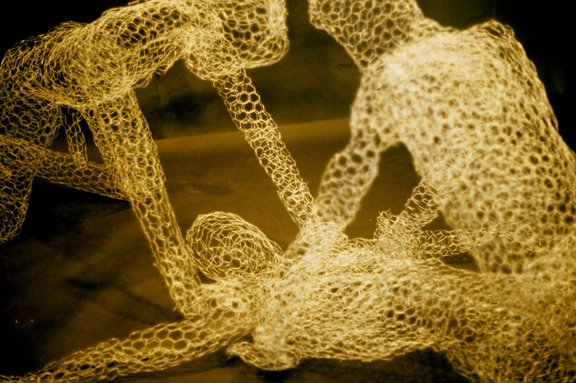By accessing the bodies of an audience or in her conventional sculpture, the artist has always employed the figure. These works leave the frame entirely, and although some images may appear quite traditional, it has been said that this is the most radical area of her work. Phyllis Braff, in The New York Times, Sunday, May 5, 1991 wrote. “ The figure’ s rich historical and artistic associations make it the perfect vehicle through which to explore the inner and outer worlds of ourselves. In the midst of international concerns about bombing, destruction and refugees, the once-uneasy relationship between modern art and renderings of angst seems to have disappeared.”
Eleanor Heartney wrote in the Hofstra Museum catalog, 1991, “Since the Renaissance, the figure has maintained a special place in the history of Western art. A contradictory tradition, it may be employed both to celebrate our common humanity and to give expression to private fantasies and nightmares.”
Indeed, the figure in Thea’ s series Images of Transformation “reflects an embrace of the complexities and contradictions of human existence. The body shelters the self – a fragile vessel embarking on a fearsome journey toward spiritual discovery and transformation.”
FIGURE
Daphne, proposed for Land Marks at Bard College 1985
Journal at Queens Museum Installation 1989
Images of Transformation 1990-1991
Sabine Woman Mixed Media 1993-1996
Sabine Woman Installation 1993
Sabine Woman Works on Paper 1982-1985
Works on Paper and Aluminum 1992-1993
Following these works, in 1996, Thea created Sabine Women, an installation of life sized figures made from chicken wire and through their linear (im) materiality are an immediate connection to her works and a correlation to the themes of war and rape in the history of art. An audio recording accompanies this work with quotes from news articles about victims of rape.
Decoy, works on paper and aluminum are motivated, in part, by the human rights abuses committed during the 1991-95 Croatian War.
In 1996, her mother’ s death seems to have triggered the artist’ s last art works, Material Identities, an installation in which the artist probes the continuous narrative suggested by her female ancestors. This mixed media work made up of five sculptures — sewed or collaged fabric, paper, copper tubing, light bulbs and wires. Each hangs from ceiling to floor, close to thewall or away like a soft complex divider, or an apparition.
When the artist traveled solo to see exhibitions in Europe in 1996, she began a new journey, unforeseen or not, as an arts writer.






